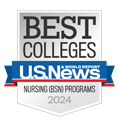Drs. Talsma and Tschannen Develop Tool to Aid in Treatment of Pressure Ulcers
The Pressure Ulcer Clinical Care Daily provides nurses with data that is salient to the treatment of pressure ulcers in order to facilitate timely and directed care.
 Two U-M School of Nursing faculty—Assistant Professor Dr. AkkeNeel Talsma and Clinical Assistant Professor Dr. Dana Tschannen—have developed a tool to assist nurses in making the best possible clinical decisions regarding treatment and prevention of pressure ulcers in acute care settings. The tool, called the Pressure Ulcer (PU) Clinical Care Daily (or “Daily”), has been implemented in several nursing units at the University of Michigan Hospital. An article reporting the most recent results of the PU Daily research was published in Applied Clinical Informatics at the end of 2011.
Two U-M School of Nursing faculty—Assistant Professor Dr. AkkeNeel Talsma and Clinical Assistant Professor Dr. Dana Tschannen—have developed a tool to assist nurses in making the best possible clinical decisions regarding treatment and prevention of pressure ulcers in acute care settings. The tool, called the Pressure Ulcer (PU) Clinical Care Daily (or “Daily”), has been implemented in several nursing units at the University of Michigan Hospital. An article reporting the most recent results of the PU Daily research was published in Applied Clinical Informatics at the end of 2011.
“The beauty of the Daily is that it takes information that is currently being collected in various information systems and brings it all into one page which can quickly be reviewed and acted upon,” Dr. Tschannen explained regarding the PU Daily. The Daily draws on data from patients’ Electronic Medical Records and isolates the data items that are salient to the treatment of pressure ulcers. Examples of data items included in the report are patient demographics, PU risk factors, status of PU’s, and implemented interventions. “We wanted something that could be acted upon—not just a summary of data but a means of putting the whole picture together that helps nurses take action sooner,” said Dr. Tschannen.
In the study conducted at U-M Hospital, nursing leads in the Cardiovascular Center intensive care (CVC ICU) unit received patients’ tailored PU Daily reports via email at the start of their shifts. The leads printed the reports and kept them on hand throughout the workday as a rounding tool. The Daily allowed nursing leads to focus on patients at highest risk of PU development by (1) assessing the skin directly with the staff nurse, (2) providing education on PU staging, assessment, and treatment alternatives, and (3) collaborating with other healthcare professionals on treatment modalities. The decision to package the Daily as a print-out instead of keeping the information in an electronic format came from preferences expressed by the nurses with whom the researchers collaborated. “What’s unique about this project is that we really have a project run by nurses for nurses,” said Dr. Talsma.
The findings of the study indicate that the PU Daily intervention was successful in reducing the number of PU’s acquired in an ICU setting. The research team is now in the beginning stages of implementing several major revisions to the Daily. First, an integrated Daily is being developed to incorporate information on multiple nurse sensitive indicators, such as falls and urinary tract infections. Furthermore, Dr. Talsma is collaborating with the School of Engineering to develop embedded sensor technology that would send out wireless alerts notifying nurses that a patient should be turned or redressed. “[This technology] would mean much more pointed and directed, patient-centered care,” said Dr. Talsma.
The multidisciplinary Clinical Care Daily Workgroup that designed the Daily was comprised of clinical nursing staff, nutritionists, wound care specialists, School of Nursing faculty, and database programmer Jan Gombert. “We had the great fortune of working with an IT person who was flexible and willing to go with us,” said Dr. Talsma of Gombert. Also essential to the success of the study was supportive nurse leadership, in particular Stephanie Diccion-MacDonald, Director of Nursing and Patient Care Services at the CVC, and Jole Mowry, nurse manager at the CVC ICU.
Recent changes in healthcare insurance coverage helped spark the researchers’ interest in improving treatment and prevention of PU’s. In 2005, the Center for Medicare & Medicaid Services adopted the Inpatient Prospective Payment System, which meant that hospitals would no longer receive additional compensation to care for patients who acquired PU’s while under their care. This legislative change, along with a shift in perspective on PU’s as no longer an acceptable consequence of prolonged hospital stays, brought new awareness to the issue of PU prevention and to nurses’ responsibility in the issue.
In 2009, Dr. Talsma, Dr. Tschannen and the Clinical Care Daily Workgroup received the U-M Business Intelligence Honorable Mention Award for the development of the PU Daily.





